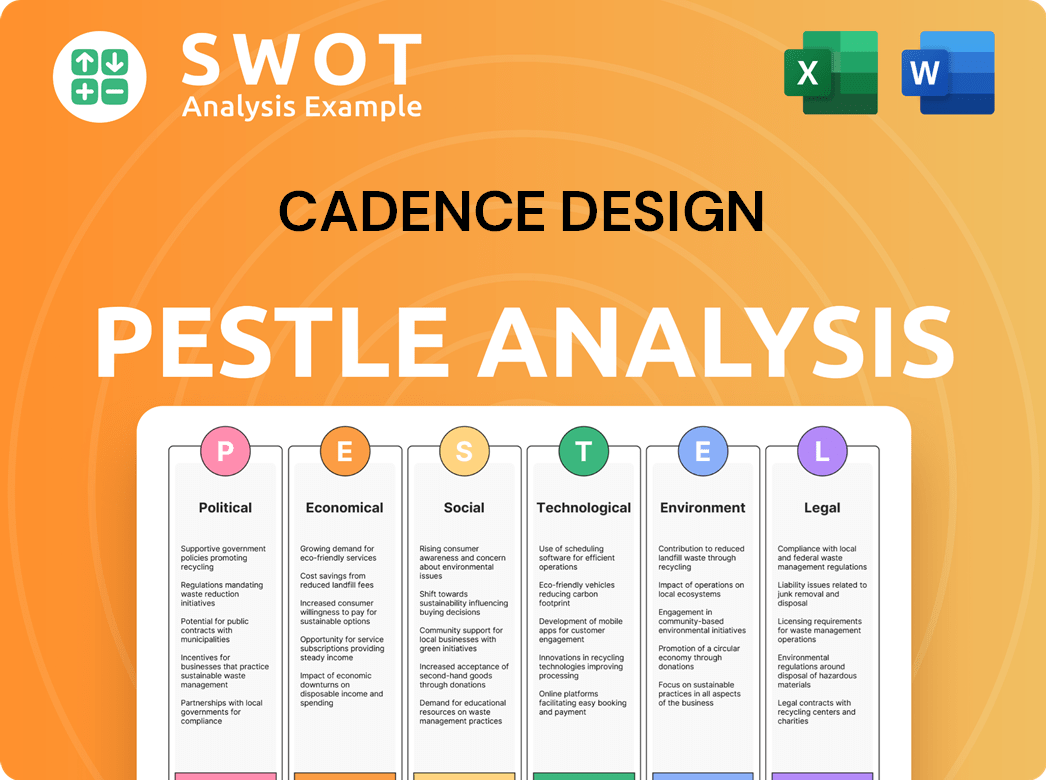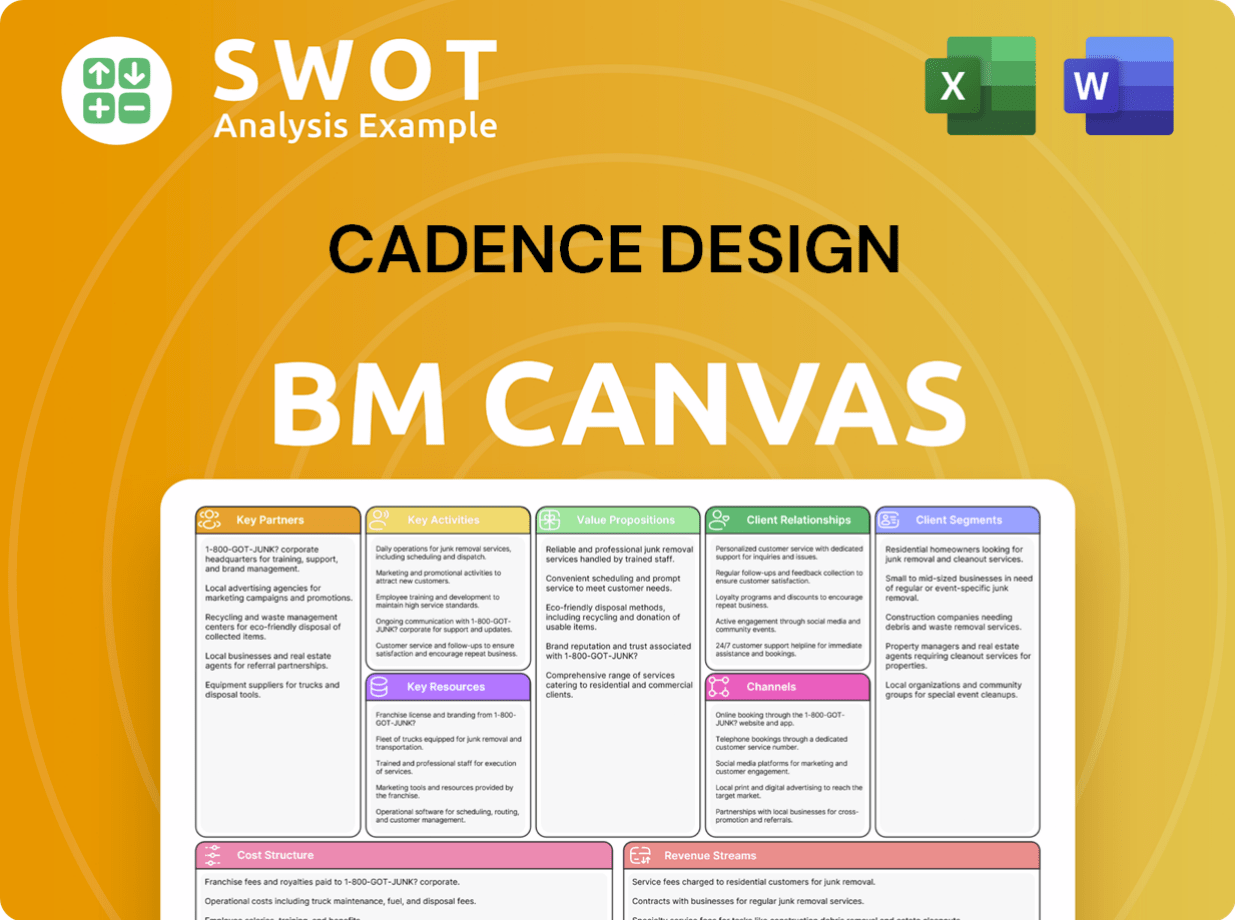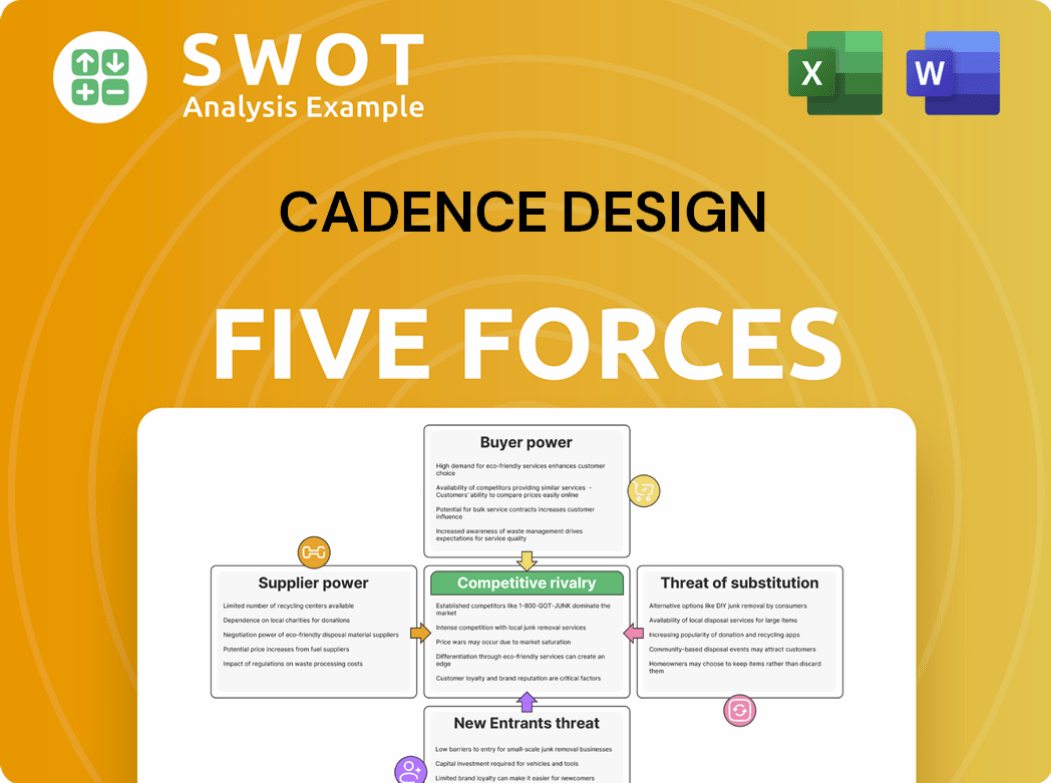Cadence Design Bundle
How Does Cadence Design Systems Dominate the EDA Industry?
In the dynamic world of electronic design automation (EDA), understanding the Cadence Design SWOT Analysis is crucial for investors and industry professionals alike. Cadence Design Systems stands at the forefront, enabling the creation of the cutting-edge technology we rely on daily. But how does this industry giant maintain its competitive edge in a sector defined by relentless innovation and fierce competition?

This exploration dives deep into the competitive landscape of Cadence Design Systems, offering a detailed market analysis of its rivals and strategies. We'll dissect its competitive advantages, examine its position within the EDA industry, and analyze its competitors to provide actionable insights. From Cadence Design Systems market share to its product portfolio, this analysis equips you with the knowledge to navigate the complexities of this critical sector, including Cadence Design Systems vs Synopsys and Cadence Design Systems vs Mentor Graphics.
Where Does Cadence Design’ Stand in the Current Market?
Cadence Design Systems holds a strong position in the Electronic Design Automation (EDA) industry. This sector is essential for developing semiconductors and electronic systems. Cadence, along with Synopsys and Siemens EDA, forms the 'Big Three' of the EDA industry, collectively dominating the market share. The EDA market experienced a year-over-year revenue increase in the first quarter of 2024, indicating a healthy and growing sector where Cadence plays a leading role.
Cadence's core operations revolve around providing software, hardware, and intellectual property (IP) used in the design and verification of electronic products. Their tools are crucial for designing integrated circuits (ICs), systems-on-chips (SoCs), and printed circuit boards (PCBs). This includes digital design and signoff, custom IC design, verification, IP, and system analysis. Cadence serves a broad customer base, including semiconductor companies, consumer electronics manufacturers, and aerospace and defense contractors.
The company's value proposition lies in enabling its customers to innovate and bring complex electronic products to market faster and more efficiently. Cadence's tools help reduce design cycles, improve product performance, and lower development costs. This is achieved through advanced software, hardware, and IP solutions that address the evolving needs of the semiconductor and electronics industries. For a deeper understanding of the company's target audience, you can explore the Target Market of Cadence Design.
Cadence Design Systems is a key player in the EDA industry. It competes with Synopsys and Siemens EDA. These three companies collectively hold the majority of the market share. The EDA market is experiencing growth, with Cadence playing a leading role.
Cadence offers a wide range of products. These include digital design and signoff tools, custom IC design software, verification solutions, and IP. The company's tools are used to design ICs, SoCs, and PCBs. Cadence also provides verification hardware and IP cores to enhance their offerings.
Cadence has a strong global presence. It has significant operations in North America, Asia, and Europe. The company's presence is particularly strong in key semiconductor manufacturing hubs like Taiwan, South Korea, and China. This global footprint supports its extensive customer base.
Cadence reported revenues of approximately $4.09 billion for the fiscal year 2023. This demonstrates the company's substantial financial scale within the EDA industry. Cadence's financial performance reflects its strong market position and the growing demand for its products.
Cadence's key strengths include its comprehensive product portfolio, strong customer relationships, and global presence. The company's competitive advantages stem from its ability to provide integrated solutions. This includes software, hardware, and IP, and its focus on innovation and customer support.
- Strong market position in the EDA industry.
- Diversified product offerings, including software, hardware, and IP.
- Global presence with a strong foothold in key markets.
- Consistent financial performance and revenue growth.
Cadence Design SWOT Analysis
- Complete SWOT Breakdown
- Fully Customizable
- Editable in Excel & Word
- Professional Formatting
- Investor-Ready Format

Who Are the Main Competitors Challenging Cadence Design?
The competitive landscape within the EDA industry is concentrated, with a few major players vying for market share. Cadence Design Systems faces intense competition from both direct and indirect competitors, necessitating continuous innovation and strategic adaptation. Understanding the strengths and weaknesses of these competitors is crucial for assessing Cadence's market position and future prospects.
The EDA market is dynamic, with shifts in technology and customer demands influencing the competitive environment. The rise of AI, advanced packaging, and cloud-based design platforms presents both opportunities and challenges for Cadence Design Systems and its rivals. A thorough market analysis is essential to navigate these complexities and make informed decisions. For further insights, you can explore the Growth Strategy of Cadence Design.
Cadence Design Systems's primary competitors include Synopsys and Siemens EDA. These companies offer a range of EDA tools and solutions, competing directly with Cadence across various product lines. The competitive dynamics involve continuous innovation, strategic acquisitions, and a focus on emerging areas like AI-driven design. Several smaller and specialized EDA companies, along with in-house design teams at large semiconductor firms, also contribute to the competitive landscape.
Synopsys is Cadence's most significant direct competitor, offering a comprehensive portfolio of EDA software, IP, and verification solutions. The rivalry between the two companies is characterized by continuous innovation and strategic acquisitions. Both companies are heavily invested in providing solutions for the development of AI chips, a rapidly growing segment.
Siemens EDA, acquired by Siemens in 2017, provides a broad range of EDA tools, with particular strengths in PCB design, design-for-test, and automotive electronics. Its strong presence in specific vertical markets and its integration with Siemens' broader industrial software portfolio present a significant competitive challenge. In 2024, Siemens Digital Industries Software reported revenue of approximately $5.6 billion, a portion of which comes from its EDA business.
Indirect competitors include smaller, specialized EDA companies focusing on niche areas and in-house design teams at large semiconductor companies. Emerging players in open-source EDA tools or cloud-based design platforms could disrupt the traditional competitive landscape. The ongoing consolidation in the EDA market, such as the acquisition of Ansys by Synopsys, reshapes the competitive dynamics.
Cadence Design Systems and Synopsys collectively hold a significant portion of the EDA industry market share. Precise market share figures fluctuate, but both companies consistently rank among the top players. The EDA market is projected to continue growing, with forecasts indicating sustained expansion in the coming years. The global EDA market was valued at approximately $13.2 billion in 2023 and is projected to reach $19.4 billion by 2028.
Key competitive factors include the breadth and depth of product portfolios, technological innovation, customer support, pricing strategies, and strategic partnerships. The ability to adapt to changing market demands, such as the increasing importance of AI and cloud-based solutions, is crucial for sustained success. Both Cadence Design Systems and Synopsys invest heavily in research and development to maintain a competitive edge.
Recent trends include the growing adoption of AI in design automation, the increasing complexity of semiconductor designs, and the rise of cloud-based EDA solutions. Acquisitions and partnerships are common strategies for expanding product portfolios and entering new markets. For example, Synopsys acquired Ansys in 2024 to enhance its capabilities in simulation and analysis.
Cadence Design Systems has several competitive advantages, including a strong brand reputation, a comprehensive product portfolio, and a large customer base. However, the company faces challenges such as intense competition from Synopsys and Siemens EDA, the need for continuous innovation, and the impact of economic cycles on the semiconductor industry.
- Key Strengths: Strong product portfolio, established customer relationships, and technological expertise.
- Key Weaknesses: Dependence on the semiconductor industry, exposure to economic downturns, and intense competition.
- Competitive Advantages: Innovation in AI-driven design, strategic partnerships, and a focus on emerging technologies.
- Challenges: Competition from Synopsys and Siemens EDA, the need for continuous investment in R&D, and the impact of market volatility.
Cadence Design PESTLE Analysis
- Covers All 6 PESTLE Categories
- No Research Needed – Save Hours of Work
- Built by Experts, Trusted by Consultants
- Instant Download, Ready to Use
- 100% Editable, Fully Customizable

What Gives Cadence Design a Competitive Edge Over Its Rivals?
Cadence Design Systems (Cadence) holds a prominent position in the Electronic Design Automation (EDA) industry, marked by key milestones and strategic moves that have shaped its competitive edge. The company's evolution reflects a commitment to innovation and strategic acquisitions, solidifying its market presence. A deep dive into the competitive landscape reveals Cadence's strengths, weaknesses, and how it stacks up against its rivals, providing a comprehensive market analysis.
Cadence's journey is characterized by continuous innovation and strategic acquisitions, aimed at expanding its product portfolio and market reach. These moves have enabled Cadence to offer comprehensive solutions, from system design to silicon realization, thereby enhancing its competitive position. For more insights into Cadence's financial performance and revenue streams, consider exploring Revenue Streams & Business Model of Cadence Design.
The EDA industry is highly competitive, with companies like Synopsys and Siemens EDA (Mentor Graphics) vying for market share. Cadence's ability to innovate and adapt to the evolving needs of the semiconductor industry is crucial for maintaining its competitive advantage. The company's financial performance reflects its market position and its ability to capitalize on industry trends.
Cadence's proprietary technologies and extensive intellectual property portfolio are key competitive advantages. The company invests heavily in R&D, resulting in a vast array of patents and trade secrets. Cadence's advanced algorithms, simulation technologies, and synthesis tools enable engineers to tackle complex chip designs.
Cadence has built strong customer relationships and brand equity over decades. The company works closely with leading semiconductor companies, fostering loyalty and creating high switching costs. Cadence's comprehensive suite of tools provides a seamless flow from system design to silicon realization, enabling faster time-to-market.
Cadence benefits from economies of scale in R&D and sales, allowing for investments in cutting-edge technologies. A highly skilled talent pool of engineers and domain experts is another critical asset. These advantages have evolved over time, with Cadence continuously adapting to new design challenges.
Cadence's sustained investment in R&D and strategic acquisitions aims to ensure the sustainability of its competitive edge. The company continuously adapts its technology and strategy to address new design challenges, such as the rise of heterogeneous computing and AI. Recent acquisitions have further strengthened its product portfolio.
Cadence Design Systems has several key competitive advantages that contribute to its success in the EDA industry. These advantages include a strong focus on innovation, deep customer relationships, and a comprehensive product portfolio. The company's ability to adapt to the evolving needs of the semiconductor industry is also a significant strength.
- Proprietary Technologies and IP: Cadence invests heavily in R&D, leading to a vast array of patents and trade secrets.
- Customer Relationships and Brand Equity: Cadence works closely with leading semiconductor companies, fostering strong customer loyalty.
- Economies of Scale: Cadence benefits from economies of scale in R&D and sales, allowing for investments in cutting-edge technologies.
- Talent Pool: Cadence has a highly skilled talent pool of engineers and domain experts.
Cadence Design Business Model Canvas
- Complete 9-Block Business Model Canvas
- Effortlessly Communicate Your Business Strategy
- Investor-Ready BMC Format
- 100% Editable and Customizable
- Clear and Structured Layout

What Industry Trends Are Reshaping Cadence Design’s Competitive Landscape?
In the dynamic EDA industry, Cadence Design Systems holds a significant position, navigating a landscape shaped by rapid technological advancements and evolving market demands. The company's success hinges on its ability to innovate and adapt to the complexities of modern chip design. This involves addressing industry-specific risks and capitalizing on emerging opportunities to maintain and expand its market share.
The future outlook for Cadence Design Systems is influenced by several factors, including the growth of the semiconductor market, the adoption of advanced technologies like AI and ML, and the strategic decisions of its competitors. Understanding these elements is crucial for assessing Cadence's long-term potential and its ability to deliver sustained value to its stakeholders. For a deeper dive into their marketing approach, consider reading about the Marketing Strategy of Cadence Design.
The EDA industry is experiencing growth driven by the increasing complexity of chip designs. Advancements in AI, ML, 5G, and HPC are key drivers. These technologies necessitate more sophisticated EDA tools, encouraging innovation in areas like system-level design and advanced verification.
The shift towards multi-die systems and advanced packaging technologies is another critical trend. As Moore's Law approaches its limits, integrating multiple dies in a single package is becoming more common. This drives demand for EDA solutions capable of managing 3D-IC design and thermal management.
Geopolitical tensions and their impact on global supply chains pose a significant challenge. The high costs associated with R&D in EDA and the need for specialized talent are also critical. Furthermore, keeping pace with the rapid evolution of semiconductor manufacturing processes, like sub-3nm nodes, presents ongoing challenges.
Significant opportunities exist in emerging markets, particularly in regions investing in domestic semiconductor industries. The proliferation of IoT devices, autonomous vehicles, and edge computing creates new avenues for growth. Cadence is strategically deploying resources to expand its portfolio in system analysis and AI-driven design.
Cadence is focusing on continuous innovation and strategic partnerships to maintain its competitive edge. The company is actively expanding its portfolio in system analysis, AI-driven design, and advanced packaging solutions to meet evolving industry demands. These efforts are crucial for sustaining growth and market leadership in the EDA industry.
- Market Analysis: The EDA market is projected to reach \$15.6 billion by 2027, growing at a CAGR of 7.8% from 2020 to 2027.
- Competitive Landscape: Key competitors include Synopsys and Siemens EDA.
- Financial Performance: Cadence's revenue for 2023 was approximately \$3.5 billion, demonstrating strong financial health and market position.
- Product Portfolio: Cadence offers a broad range of tools for IC design, verification, and analysis, catering to diverse customer needs.
Cadence Design Porter's Five Forces Analysis
- Covers All 5 Competitive Forces in Detail
- Structured for Consultants, Students, and Founders
- 100% Editable in Microsoft Word & Excel
- Instant Digital Download – Use Immediately
- Compatible with Mac & PC – Fully Unlocked

Related Blogs
- What are Mission Vision & Core Values of Cadence Design Company?
- What is Growth Strategy and Future Prospects of Cadence Design Company?
- How Does Cadence Design Company Work?
- What is Sales and Marketing Strategy of Cadence Design Company?
- What is Brief History of Cadence Design Company?
- Who Owns Cadence Design Company?
- What is Customer Demographics and Target Market of Cadence Design Company?
Disclaimer
All information, articles, and product details provided on this website are for general informational and educational purposes only. We do not claim any ownership over, nor do we intend to infringe upon, any trademarks, copyrights, logos, brand names, or other intellectual property mentioned or depicted on this site. Such intellectual property remains the property of its respective owners, and any references here are made solely for identification or informational purposes, without implying any affiliation, endorsement, or partnership.
We make no representations or warranties, express or implied, regarding the accuracy, completeness, or suitability of any content or products presented. Nothing on this website should be construed as legal, tax, investment, financial, medical, or other professional advice. In addition, no part of this site—including articles or product references—constitutes a solicitation, recommendation, endorsement, advertisement, or offer to buy or sell any securities, franchises, or other financial instruments, particularly in jurisdictions where such activity would be unlawful.
All content is of a general nature and may not address the specific circumstances of any individual or entity. It is not a substitute for professional advice or services. Any actions you take based on the information provided here are strictly at your own risk. You accept full responsibility for any decisions or outcomes arising from your use of this website and agree to release us from any liability in connection with your use of, or reliance upon, the content or products found herein.